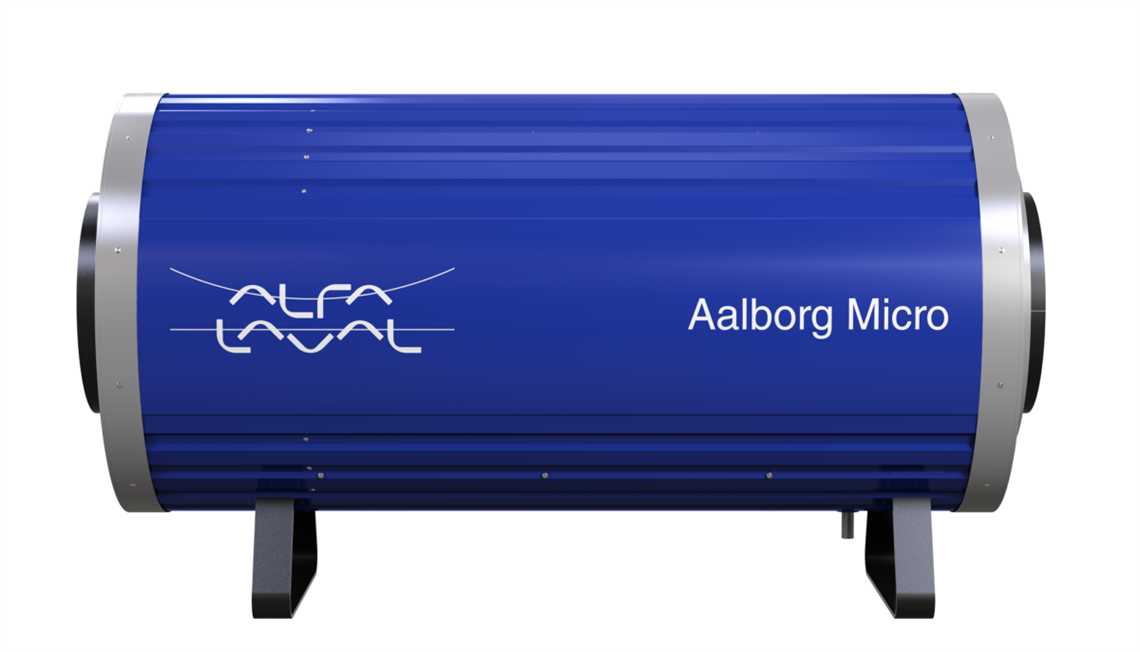Alfa Laval Goes Micro
29 March 2017

BY BO SVENSSON
For over a century, Aalborg Industries has produced boilers and heat exchangers for industrial as well as marine applications.
The boilers manufactured by the company, which is part of the Alfa Laval group, have often been large, and suitable for burning a variety of fuels, both solid and fluid. Heat recovery boilers for gas turbines as well as for reciprocating engines also have been important products for the company.
Now, Alfa Laval sees a market interest in smaller waste heat recovery systems. They are now introducing a highly efficient, small, waste heat recovery unit that provides thermal power in the range of 250 to 5000 kW by utilizing waste heat from smaller gas and diesel engines as well as gas turbines. Today’s focus on producing power in an efficient and environmentally friendly mode has made the market for smaller gas turbines and reciprocating engines interested in limiting the waste heat through the exhaust stacks, the company said.
The Aalborg Micro, recently being introduced by Alfa Laval, is a waste heat recovery unit highly applicable for installation after smaller gas and diesel engines as well as gas turbines. It can use liquefied natural gas (LNG), marine diesel oil (MDO) or heavy fuel oil (HFO). The Aalborg Micro can be installed horizontally or vertically, and located indoor as well as outdoor, the company said.
The interest in cogeneration is certainly not a new thing and is found within industry and communities. Many industries use heat in their production and also have, like communities, a need for warming up its facilities. District heating is another area, where waste heat recovery from power plants has become economic.
“Aalborg Micro is a highly efficient and compact heat exchanger utilizing waste heat from flue gasses to improve the thermal capacity of gen-sets as well as organic Rankine cycle processes,” said Jesper Kaalbye, product manager, Product Center Boilers, Alfa Laval. “Aalborg Micro is fit for a number of various media such as hot water, TEG (tri-ethylene-glycol) and TFO (thermal fluid oil); but also for production of steam.”
One advantage offered by the Aalborg Micro is its ability to operate without a 100% by-pass. The unit can be run dry without problems, and it also has an internal regulation damper allowing a partial, internal by-pass of the coils. This integrated regulation damper ensures, that a significant amount of the flue gas can be lead outside the heating surface. This provides unique possibilities for adjusting the Micro depending on required output. In some cases, the Micro also offers natural circulation, why circulation pumping is avoided.
An exhaust gas temperature up to 600o C from the turbine/engine can be used on the Micro. The minimum temperature of the gasses leaving the heat exchanger is dependent on the fuel type and composition of the exhaust gas as well as the inlet temperature on the media side; this in order to avoid sulfidation corrosion.
The Aalborg Micro comes with a heating surface consisting of a number of co-axial tubes, which are placed in a vertical or a horizontal cylindrical shell plate. The tubes have serrated spiral fins, which significantly extend the heating surface.

“Our design of the tube package provides for an optimal heat transfer between the exhaust gas and the heating media. Since the Micro is based on a “water tube design” the total mass on the media side is extremely low, whereby inertia is significantly lower compared to conventional heat exchangers,” said Kaalbye. “The operational temperature is reached in a few minutes, and the unit’s reaction to load changes is fast as well. Furthermore, the Micro is often extremely easy to integrate and/or to retrofit due to its very low footprint. Compared to conventional heat exchangers the Micro is typically less than half the size.”
The recovery unit can be supplied with an integrated cleaning device, which makes it possible to clean the heating surface either by air, steam or water. The fact that the design can resist dry-run, makes it possible to clean by pyrolysis, i.e. heating up the surface of the coils for self-cleaning. Thereby an external by-pass is not needed.
“Cogeneration of electricity and heat results in a relatively lower specific fuel consumption, consequently leading to a lower cost for production of electricity. Traditionally the prime interest has been production of electricity, but the heat or thermal power is today also gaining interest,” said Kaalbye. “And from an environmental point of view, the improved efficiency offered by cogeneration could typically also result in lower emissions. The hot water or steam generated by using a Micro can substitute hot water or steam generated by e.g. a fired boiler, which means lower emissions of harmful gases like CO2 and NOx.”
STAY CONNECTED




Receive the information you need when you need it through our world-leading magazines, newsletters and daily briefings.
POWER SOURCING GUIDE
The trusted reference and buyer’s guide for 83 years
The original “desktop search engine,” guiding nearly 10,000 users in more than 90 countries it is the primary reference for specifications and details on all the components that go into engine systems.
Visit Now
CONNECT WITH THE TEAM









